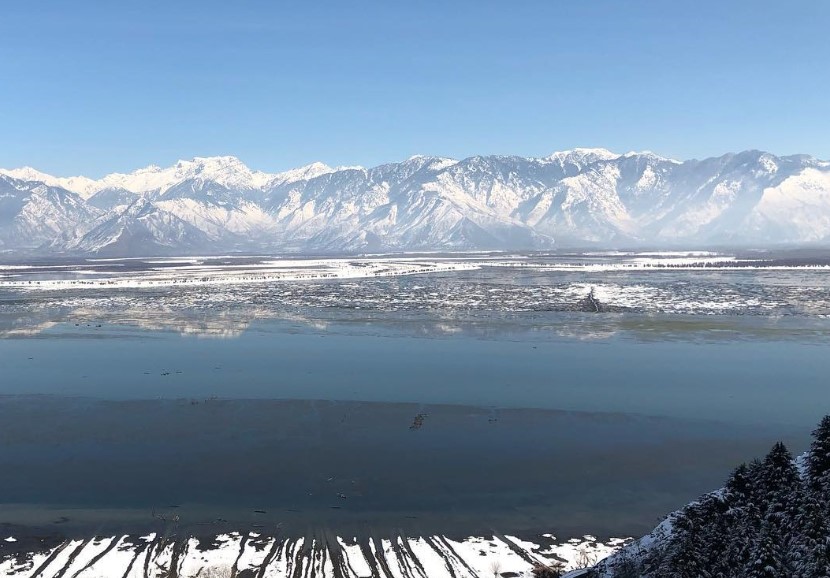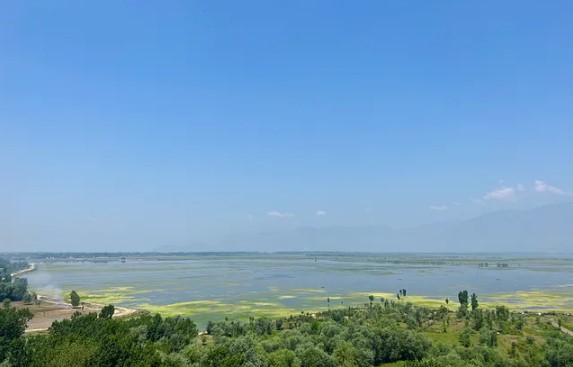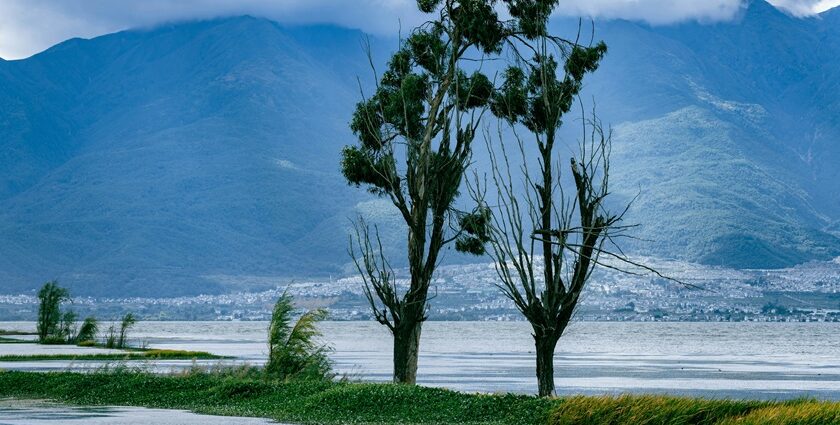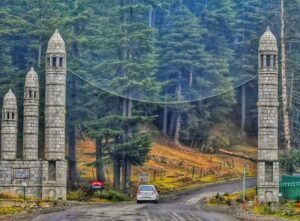Nestled amidst the snow-capped Himalayan peaks and verdant valleys of Kashmir lies a natural wonder that few travelers have truly discovered – Wular Lake. This vast expanse of shimmering waters stretches across the landscape like a liquid mirror reflecting Kashmir’s stunning mountain panorama, creating a scene of breathtaking beauty that changes with every passing hour.
Did you know? Wular Lake holds the distinction of being Asia’s largest freshwater lake, spanning an impressive area that once covered over 200 square kilometers – larger than 30,000 football fields combined!
Best time to visit: Spring (April-June) offers stunning reflections of surrounding mountains and blooming wildflowers along the shores. Early mornings (6-8 AM) provide the calmest waters and best photography opportunities as mist rises from the lake’s surface.
Beyond its awe-inspiring dimensions, Wular Lake serves as Kashmir’s ecological backbone, supporting countless species and communities. As you explore its pristine waters and marshlands, you’ll discover a world where traditional fishing communities have maintained centuries-old practices, where migratory birds find sanctuary, and where the very pulse of Kashmir’s natural rhythms can be felt.
This comprehensive Wular Lake guide will take you through its ecological wonders, hidden viewpoints, extraordinary experiences, and practical travel information – revealing why this magnificent water body deserves a prime spot on your Kashmir itinerary.
The Vital Ecological Role of Wular Lake

Wular Lake isn’t just beautiful – it’s essential to Kashmir’s environmental balance. This massive freshwater system functions as nature’s own flood control mechanism, absorbing excess water during spring snowmelt and monsoon downpours.
Did you know? Wular Lake single-handedly prevents catastrophic flooding in Srinagar and surrounding areas by absorbing millions of gallons of water from the Jhelum River during peak flow seasons!
Best time to visit: Autumn (September-October) showcases Wular Lake’s flood regulation capabilities as water levels rise dramatically. Midday (10 AM-2 PM) offers the clearest views of the lake’s full expanse and surrounding watershed.
A Biodiversity Hotspot of International Importance
Recognized as a Ramsar Wetland Site of International Importance, Wular Lake hosts an extraordinary array of life forms. Its crystal-clear waters nurture vast beds of lotus and water chestnuts that sway gently with the currents, while beneath the surface, numerous fish species dart among the aquatic vegetation.
The lake’s ecosystem supports:
- Aquatic Flora: Expansive growths of nadru (lotus stem) create floating gardens that local communities harvest for their prized culinary delicacy. The vibrant pink lotus blooms (July-August) transform sections of Wular Lake into a painting come alive.
- Thriving Fisheries: Wular Lake produces over 60% of Kashmir’s freshwater fish, with species like the endemic Schizothorax (Snow Trout) supporting generations of traditional fishermen from villages like Zurimanz and Lankreshpora that dot the shoreline.
- Rich Birdlife: A paradise for ornithologists, Wular Lake transforms into a bird sanctuary each winter when thousands of migratory birds arrive from distant lands.
Bird Species You Might Spot at The Lake:
Resident Birds:
- Elegant White Egrets stalking the shallows
- Majestic Grey Herons standing sentinel along reed beds
- Vibrant Kingfishers diving for fish from overhanging branches
- Patient Pond Herons waiting motionless for prey
Winter Migratory Visitors (November-February):
- Honking flocks of Greylag Geese creating V-formations across the sky
- Graceful Northern Pintails with their distinctive long necks
- Colorful Common Pochards diving for underwater vegetation
- Swift Eurasian Wigeons skimming the water’s surface
- Broad-billed Northern Shovelers filtering water for tiny organisms
Birds of Prey:
- The rare Pallas’s Fish Eagle soaring majestically above
- Western Marsh Harriers gliding low over reeds in search of prey
Did you know? Wular Lake serves as a critical stopover on the Central Asian Flyway, with some migratory birds traveling over 5,000 miles from Siberia to winter here!
Best time for birdwatching: Winter mornings (November-February, 7-10 AM) offer peak bird activity when hundreds of waterfowl species gather in impressive numbers.
Challenges Facing Wular Lake & Conservation Efforts
Despite its importance, Wular Lake faces significant threats:
- Sedimentation: Soil erosion from deforested watersheds is gradually filling in the lake basin.
- Pollution: Agricultural runoff and waste from surrounding communities threatens water quality.
- Encroachment: Willow plantations and agricultural conversion have reduced the lake’s size by nearly 40% over the past century.
Fortunately, the dedicated Wular Conservation and Management Authority (WUCMA) is making significant strides in restoration. Their efforts include removing invasive vegetation, dredging accumulated silt, and creating buffer zones to protect this precious ecosystem.
Did you know? WUCMA has successfully removed over 500,000 cubic meters of silt from Wular Lake since 2018, restoring vital habitat and water storage capacity!
Best time to witness conservation work: Spring (March-May) when dredging operations and wetland restoration work is most active. Late afternoons (3-5 PM) offer good visibility of conservation zones.
Your Complete Visitor’s Guide

How to Reach the Shores of Wular Lake
Wular Lake spreads across Bandipora district, with its vast shoreline touching parts of Baramulla and Srinagar districts. Its accessibility makes it an excellent day trip from Kashmir’s major tourist centers.
Getting to Wular Lake:
- Distance from Srinagar: 35-60 km (depending on which access point you choose)
- Travel Time: 1.5-2 hours by road
- Best Transportation: Private taxi offering flexibility to visit multiple viewpoints
Did you know? The roads to Wular Lake wind through apple orchards and saffron fields, making the journey almost as spectacular as the destination itself!
Best time for road travel: Early morning (7-9 AM) to avoid traffic and catch the lake in its morning splendor. Spring through autumn offers the most reliable road conditions.
Prime Wular Lake Viewpoints & Experiences
1. Watlab Hill & Baba Shukurddin Shrine
This elevated viewpoint offers the most dramatic panoramas of Wular Lake, with the vast waters stretching seemingly endlessly below. The hilltop is crowned by the serene Baba Shukurddin shrine, a white-domed structure that has watched over the lake for centuries.
From this vantage point, you can see how the Jhelum River flows into Wular Lake, creating complex patterns of currents across the water’s surface. On clear days, the distant peaks of the Himalayan range form a perfect backdrop to this natural amphitheater.
Did you know? Legend has it that Baba Shukurddin, a revered Sufi saint, once calmed a violent storm on Wular Lake by simply raising his hand, saving dozens of fishermen from certain death!
Best time to visit: Late afternoon to sunset (4-6 PM) when golden light bathes the landscape and creates spectacular reflections on Wular Lake’s surface. October-November offers crisp clear views.
2. Ningli Tarzoo (Near Sopore)
This picturesque fishing village sits at the northwestern edge of Wular Lake, where traditional wooden boats bob gently at makeshift docks. The shoreline here is alive with activity – fishermen mending nets, women sorting the day’s catch, and water chestnut harvesters preparing their floating platforms.
Ningli offers the most authentic glimpse into the lives of communities who have depended on Wular Lake for generations. The village backdrop, with its distinctive wooden houses and smoking chimneys, creates a perfect composition for photography enthusiasts.
Did you know? The fishermen of Ningli Tarzoo use a unique technique called “Gad” fishing, where they create small enclosures of reeds in Wular Lake to trap fish – a sustainable practice passed down through 15 generations!
Best time to visit: Early morning (5:30-7:30 AM) to witness fishermen heading out on Wular Lake for their morning catch. Summer months (June-August) showcase peak fishing activity.
3. Bandipora Town Waterfront
The southern shores of Wular Lake touch Bandipora town, where a recently developed waterfront promenade allows visitors to stroll along the edge of the vast lake. This access point offers the most convenient facilities, including snack vendors, public restrooms, and boat rental services.
From here, the lake stretches northward to the horizon, with the distinctive peaks of Haramukh mountain often visible on clear days. The gentle slope of the shoreline creates shallow waters ideal for observing wading birds and aquatic plants.
Did you know? Bandipora’s name derives from “Band” (dam) and “por” (settlement), referring to an ancient dam that once regulated Wular Lake’s water levels over 600 years ago!
Best time to visit: Late mornings (10 AM-12 PM) when local markets are bustling and boat operators are readily available. Spring (April-May) brings wildflowers along the shoreline.
Unforgettable Experiences at Wular Lake

Boating Adventures
No visit to Wular Lake is complete without experiencing its vastness from the water itself. Local fishermen offer traditional wooden boat tours that allow you to glide silently across the lake’s surface, surrounded by nothing but water, sky, and distant mountains.
As you venture further from shore, you’ll discover hidden corners of Wular Lake – floating gardens of lotus and water chestnuts, secluded fishing spots, and marshy areas where birds nest undisturbed. The gentle lapping of water against your boat and the occasional call of a kingfisher create a soundtrack of perfect tranquility.
Types of Boating Experiences on Wular Lake:
- Traditional Wooden Boats: Authentic experiences with local fishermen who share generations of knowledge about Wular Lake (best for photography and slow exploration)
- Motorboats: Cover more distance to reach remote areas of the lake (ideal for birdwatching expeditions)
- Sunset Cruises: Special arrangements can be made for evening boat rides when Wular Lake’s surface turns golden (perfect for romantic experiences)
Important Safety Tips for Boating on Wular Lake:
- Negotiate price, route, and duration before boarding
- Ensure the boat is sturdy and well-maintained
- Ask for life jackets if available
- Avoid boating in poor weather — storms can roll in quickly on open water
- Respect your boatman’s advice about safe areas to navigate
Did you know? Wular Lake’s name comes from the Sanskrit word “Ullola” meaning “stormy” – a reference to how quickly conditions can change on this vast water body when mountain winds sweep down!
Best time for boating: Early mornings (6-9 AM) when Wular Lake’s waters are calmest and mist creates magical atmospherics. May-June offers pleasant temperatures and good visibility.
Wular Lake: A Birdwatcher’s Paradise
For bird enthusiasts, Wular Lake offers world-class opportunities to observe both resident and migratory species in their natural habitat. The lake’s diverse ecosystem – from deep open waters to shallow marshy edges – creates multiple microhabitats that support different bird species.
What Makes Wular Lake Special for Birdwatching:
- Extensive reed beds provide perfect nesting sites for small warblers and bitterns
- Shallow marshes attract wading birds like herons and egrets
- Open waters host diving ducks and grebes
- Surrounding agricultural fields bring seed-eating species to the lake edges
Essential Birdwatching Tips:
- Bring quality binoculars or a spotting scope (at least 8×42 magnification recommended)
- Arrive at dawn when birds are most active feeding
- Move slowly and quietly, wearing neutral colors
- Consider hiring a knowledgeable local guide who knows the best spots
- Keep a field guide handy to identify the numerous species
Did you know? Over 240 bird species have been documented at Wular Lake, making it one of the richest avian habitats in the entire Himalayan region!
Best time for birdwatching: Winter mornings (November-February, 6:30-9:30 AM) for migratory waterfowl; Spring (March-April) for breeding behaviors and nesting activities.
Experiencing Local Culture Around The Lake
The communities surrounding Wular Lake have developed unique cultural traditions intimately connected to the lake’s rhythms. A visit here offers glimpses into traditional Kashmiri rural life that few tourists experience.
Cultural Highlights Around Wular Lake:
- Traditional Fishing Demonstrations: Watch skilled fishermen cast their nets using techniques unchanged for centuries
- Handicrafts: Local artisans create distinctive fish-themed woven baskets and mats from lake reeds
- Culinary Traditions: Sample authentic water chestnut flour bread (singharay ki roti) and lotus stem curry (nadru yakhni) – specialties from Wular Lake’s harvest
Did you know? The fishing communities around Wular Lake have their own unique dialect that includes over 50 words just to describe different types of water conditions on the lake!
Best time for cultural experiences: Summer evenings (June-August, 4-7 PM) when village activities are most visible and festivals occasionally take place. Autumn (September-October) brings harvest celebrations.
Practical Information
Seasonal Guide
Spring (March-May):
- Wular Lake comes alive with new growth and bird nesting activities
- Comfortable temperatures (15-25°C) make exploration pleasant
- Best for photography as surrounding mountains still have snow caps
- Ideal for boating and shoreline walks
Summer (June-August):
- Peak fishing season on Wular Lake with maximum cultural activities
- Warm days (25-30°C) but cooler than lower elevations
- Lotus and water lily blooms create stunning visuals
- Perfect for early morning boat rides when water is mirror-calm
Autumn (September-November):
- Wular Lake reflects golden and russet colors from surrounding forests
- Harvest season for water chestnuts and other lake products
- Clear skies offer the best mountain views across the lake
- Ideal for full-day explorations with pleasant temperatures
Winter (December-February):
- Wular Lake hosts thousands of migratory birds from Central Asia
- Cold temperatures (sometimes below freezing) but incredible birdwatching
- Misty mornings create ethereal atmospheres over the lake
- Fewer tourists mean more authentic experiences
Essential Planning Information
Facilities Available:
- Basic tea stalls and snack vendors near Watlab and Ningli Tarzoo
- Limited public restrooms – it’s advisable to carry essentials
- Mobile network coverage is generally good around the lake
- No ATMs directly at viewpoints – withdraw cash in Bandipora or Srinagar
Recommended Visit Duration:
- Minimum 5-7 hours for a relaxed trip from Srinagar
- Full day (8+ hours) ideal for combining boating, birdwatching, and multiple viewpoints
- Consider a sunrise-to-sunset experience for photography enthusiasts
Accommodation Options:
- No tourist lodging directly at Wular Lake
- Nearby Bandipora offers basic guesthouses (2-3 star equivalent)
- Most visitors base themselves in Srinagar (1-2 hour drive) where all categories of accommodation are available
Responsible Tourism:
- Support local communities by hiring guides and boatmen
- Never litter – the lake’s ecosystem is fragile
- Maintain distance from fishing operations and bird nesting sites
- Consider contributing to conservation initiatives through WUCMA
Did you know? Tourism at Wular Lake is still in its infancy, with fewer than 5,000 international visitors annually – meaning you’ll experience authentic Kashmir away from the crowds!
Best overall seasons: Spring (April-May) and autumn (September-October) offer the most balanced experiences combining good weather, cultural activities, and natural beauty at Wular Lake.
Why Wular Lake Deserves Your Attention

As you stand at the edge of Wular Lake watching the sunset paint its vast waters in amber and gold, you’ll understand why this extraordinary place captures the hearts of all who visit. Far more than just a scenic stop, Wular Lake represents Kashmir’s natural heritage in its purest form – a living, breathing ecosystem that sustains communities and wildlife alike.
Whether you’re seeking tranquil boat rides across mirror-like waters, hoping to photograph rare migratory birds, or simply wanting to experience a side of Kashmir that most travelers miss, Wular Lake offers experiences that will become cherished memories.
This magnificent freshwater giant faces an uncertain future as environmental pressures mount. By visiting respectfully, supporting local communities, and spreading awareness about its importance, you become part of the solution – helping to preserve Wular Lake for generations to come.
Visit with reverence. Explore with wonder. And let Wular Lake’s timeless beauty remind you of nature’s irreplaceable gifts to our world.


